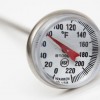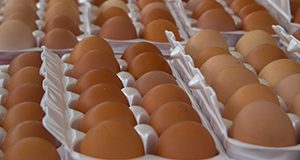Vitamin D is needed for normal absorption of calcium and phosphorus. It helps put these minerals into bones and teeth. This makes bones stronger and reduces risk for bone fractures. Vitamin D also helps keep the immune system functioning normally, so our bodies can resist some types of disease. This 3-page fact sheet is a major revision that discusses effects of vitamin D deficiency, intake recommendations, and sources of vitamin D. Written by Linda B. Bobroff and Isabel Valentín-Oquendo, and published by the UF/IFAS Department of Family, Youth and Community Sciences, revised November 2017.
http://edis.ifas.ufl.edu/fy207
Tag: Isabel Valentin-Oquendo
Facts about Vitamin D
 Vitamin D is needed for normal absorption of calcium and phosphorus. It helps put these minerals into bones and teeth. This makes bones stronger and reduces risk for bone fractures. Vitamin D also helps keep the immune system functioning normally, so our bodies can resist some types of disease. This 2-page fact sheet was written by Linda B. Bobroff and Isabel Valentín-Oquendo, and published by the UF Department of Family Youth and Community Sciences, February 2014.
Vitamin D is needed for normal absorption of calcium and phosphorus. It helps put these minerals into bones and teeth. This makes bones stronger and reduces risk for bone fractures. Vitamin D also helps keep the immune system functioning normally, so our bodies can resist some types of disease. This 2-page fact sheet was written by Linda B. Bobroff and Isabel Valentín-Oquendo, and published by the UF Department of Family Youth and Community Sciences, February 2014.
http://edis.ifas.ufl.edu/fy207
Keeping Food Safe: Choosing and Using Food Thermometers in Homes (FCS1083/HE770)
 Proper cooking of foods to safe internal temperatures is one of the most effective ways to prevent foodborne illnesses. Several types of food thermometers are available for purchase, and choosing the right one when cooking at home will help to keep food safe for your family. This 3-page fact sheet provides specific information on how to use different thermometers in different foods. Written by Claudia L. Peñuela, Amy Simonne, and Isabel Valentin-Oquendo, and published by the UF Department of Family Youth and Community Sciences, March 2012. http://edis.ifas.ufl.edu/he770
Proper cooking of foods to safe internal temperatures is one of the most effective ways to prevent foodborne illnesses. Several types of food thermometers are available for purchase, and choosing the right one when cooking at home will help to keep food safe for your family. This 3-page fact sheet provides specific information on how to use different thermometers in different foods. Written by Claudia L. Peñuela, Amy Simonne, and Isabel Valentin-Oquendo, and published by the UF Department of Family Youth and Community Sciences, March 2012. http://edis.ifas.ufl.edu/he770
Mantener los alimentos seguros: Escoger y usar termometros en casa (FCS1083Span/FY1296)
 “La cocción apropiada de los alimentos a la temperatura interna segura es una de las formas más efectivas de prevenir las enfermedades transmitidas por los alimentos. Existe una gran variedad de termómetros para comprar y seleccionar el correcto para cuando cocine en casa de manera que usted y su familia estén seguros. Esta publicación proveerá información específica de cómo usar los diferentes termómetros en diferentes alimentos.” This 3-page fact sheet was written by Claudia Peñuela, Amarat Simonne e Isabel Valentin-Oquendo, and published by the UF Department of Family Youth and Community Sciences, September 2012.
“La cocción apropiada de los alimentos a la temperatura interna segura es una de las formas más efectivas de prevenir las enfermedades transmitidas por los alimentos. Existe una gran variedad de termómetros para comprar y seleccionar el correcto para cuando cocine en casa de manera que usted y su familia estén seguros. Esta publicación proveerá información específica de cómo usar los diferentes termómetros en diferentes alimentos.” This 3-page fact sheet was written by Claudia Peñuela, Amarat Simonne e Isabel Valentin-Oquendo, and published by the UF Department of Family Youth and Community Sciences, September 2012.
http://edis.ifas.ufl.edu/fy1296
Búsqueda de palabras del grupo de los granos (FCS8725Span /FY426)
Busque en la sopa de letras alimentos del grupo de los granos. Algunos de estos granos pueden ser nuevos para usted, búsquelos en su próxima visita al supermercado y prepare nuevas recetas. ¡Puede que uno de estos granos se convierta en su favorito!
This 1-page fact sheet was written by Isabel Valentin-Oquendo and Claudia Peñuela, and published by the UF Department of Family Youth and Community Sciences, June 2011.
http://edis.ifas.ufl.edu/fy426
Planear las comidas: Para una buena nutrición (FCS1070Span/HE975)
Do you ask yourself, “What’s for dinner tonight?” Planning meals helps you save time, money, and energy. When you write out your meals, it is easier to see if your family is eating a variety of food choices, nutrient-dense foods, and the right amounts of foods for good nutrition. This 1-page Spanish-language fact sheet was written by Isabel Valentin-Oquendo y Claudia Peñuela, and published by the UF Department of Family Youth and Community Sciences, May 2011.
http://edis.ifas.ufl.edu/he975
Facts about Vitamin C (FCS8702/FY215)
Vitamin C, also known as ascorbic acid, has a wide variety of uses in the body. It helps slow down or prevent cell damage. It is needed to maintain healthy body tissues and the immune system. Vitamin C also helps our bodies absorb iron from plant foods. Learn the facts about this important vitamin with this 2-page fact sheet written by Linda B. Bobroff and Isabel Valentín-Oquendo and published by the UF Department of Family Youth and Community Sciences, December 2010.
http://edis.ifas.ufl.edu/fy215
Grains Word Search (FCS8725/FY425)
Search for foods from the Grain Group in the word search below. Some of these grains may be new to you, but try looking for them in the supermarket and then try a new recipe. Maybe you will find a new favorite! This 1-page fact sheet was written by Isabel Valentín-Oquendo and Claudia Peñuela, and published by the UF Department of Family Youth and Community Sciences, April 2011.
http://edis.ifas.ufl.edu/fy425
Planning Meals: For Good Nutrition (FCS1070/HE974)
Do you ask yourself, “What’s for dinner tonight?” Stop adding stress to your life, and try to overcome the temptation of picking up fried chicken at the supermarket or ordering pizza; these options are unhealthy and can be expensive. Instead, start planning your meals ahead of time. Planning meals helps you save time, money, and energy. Also, planning meals helps you prepare healthy meals at home. This 1-page fact sheet was written by Isabel Valentín-Oquendo and Claudia Peñuela, and published by the UF Department of Family Youth and Community Sciences, March 2011.
http://edis.ifas.ufl.edu/he974
Filling Up Your Pantry (FCS1074/HE978)
What is the best way to fill your pantry? It depends on what you like to eat and your style of cooking. Whatever your style, follow the suggestions in this 2-page fact sheet for filling up your pantry and freezer. It will help you be prepared, and save time and money. Written by Claudia Peñuela and Isabel Valentin-Oquendo. Published by the UF Department of Family Youth and Community Sciences, June 2010.
http://edis.ifas.ufl.edu/he978
FCS8640/FY207 Facts about Vitamin D
Revised! FCS8640, a 2-page illustrated fact sheet by Linda B. Bobroff and Isabel Valentín-Oquendo, summarizes key facts about vitamin D’s role in human nutrition — why we need it, what happens if we don’t get enough, how much we need, how we can get enough, supplements, and how much is too much. Includes links to reliable nutrition information on the Web. Published by the UF Department of Family Youth and Community Sciences, December 2010.
http://edis.ifas.ufl.edu/FY207
FCS8806/FY892 Facts about Sodium
Revised! FCS8806, a 2-page handout by R. Elaine Turner and Isabel Valentin-Oquendo, provides basic information about sodium in an easy to read format. Published by the UF Department of Family Youth and Community Sciences, March 2010.
http://edis.ifas.ufl.edu/fy892
FCS1099/FY201 Choosing Healthy Snacks Using MyPyramid
Revised! FCS1099, a 2-page illustrated fact sheet by Claudia Peñuela and Isabel Valentin-Oquendo, discusses healthy snacks, including snacking myths, who should snack, planning snacks, how to read food labels, and including food groups that are missing from meals. Published by the UF Department of Family Youth and Community Sciences, August 2009.
http://edis.ifas.ufl.edu/FY201
FCS1099Span/FY202 Elija Bocaditios Saludables Usando MiPirámide
Revised! FCS1099Span, a 2-page illustrated fact sheet by Claudia Peñuela and Isabel Valentin-Oquendo, is the Spanish language version of FCS1099/FY201 Choosing Healthy Snacks Using MyPyramid. It discusses healthy snacks, including snacking myths, who should snack, planning snacks, how to read food labels, and including food groups that are missing from meals. Published by the UF Department of Family Youth and Community Sciences, August 2009.
http://edis.ifas.ufl.edu/FY202
FCS8640/FY207 Facts about Vitamin D
Revised! FCS-8640, a 2-page illustrated fact sheet by Linda B. Bobroff and Isabel Valentín-Oquendo, summarizes key facts about vitamin D’s role in human nutrition — why we need it, what happens if we don’t get enough, how much we need, how we can get enough, supplements, and how much is too much. Includes links to reliable nutrition information on the Web. Published by the UF Department of Family Youth and Community Sciences, April 2009.
http://edis.ifas.ufl.edu/FY207
